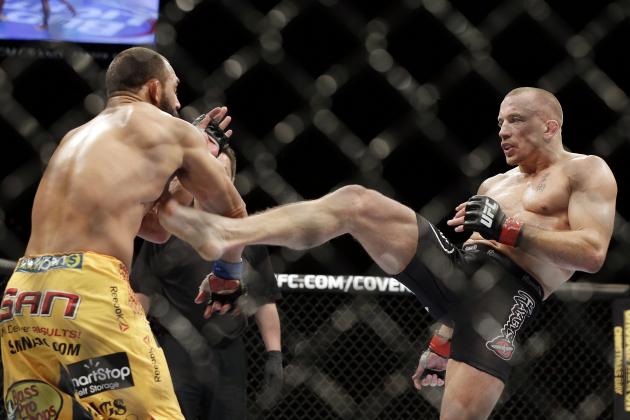An ACL injury has sidelined Georges St-Pierre again. The former UFC champion damaged his knee in training and will undergo surgery "soon." St-Pierre tweeted out the bad news on Thursday:
Tore my left ACL in training. Surgery in a few days. Rehab, pain, hard work, no shortcuts- I'll soon be back at 100%. Thanks for the support
— Georges St-Pierre (@GeorgesStPierre) March 27, 2014
It's unclear how the injury happened, but it really doesn't matter. The ACL is one of four main ligaments inside the knee and offers stability between the bones of the leg—the upper (femur) and lower (tibia). It is most stressed by hard stops and by twists.
There are a variety of ways the ACL can be damaged, but it does not necessitate significant contact. In the NFL, nearly half of the ACL injuries last year were considered non-contact. The athlete planted or twisted and the knee gave. Injuries to the ACL tend to be traumatic, meaning they break down due to one isolated incident rather than being weakened by overuse or slow buildup of damage.
While it is unclear exactly when St-Pierre will have the surgery, it is likely he will return to Dr. Neal ElAttrache at Kerlan-Jobe Orthopaedic Clinic in Los Angeles. ElAttrache, one of the top orthopaedists in the world, performed St-Pierre's surgery in 2011.
As in that one, the likely plan will be to take part of his patellar tendon and use it to replace the damaged ACL. This is standard practice for ElAttrache and for most surgeons. ElAttrache has had great luck with this procedure, including with such well-known athletes as Tom Brady and Kobe Bryant.
The normal time frame for return in most sports from this kind of surgery is between six and 12 months. There's certainly no standard for an MMA fighter, but the need for balance, strength and the possibility of taking strong kicks to the knee in fights puts the timeline at around 12 months. (If you're interested in more info about how the timeline goes in detail, see this article. While this refers specifically to Rajon Rondo, the rehab is roughly similar for most athletes up to sports-specific stages.)
That matches up with the time it took St-Pierre to return from his previous ACL reconstruction, though the time between fights was almost six months longer. Timing and scheduling often make it difficult to determine the true rehab timeline. If St-Pierre was ready to fight at 12 months but there was no fight, that's much the same as Adrian Peterson saying he could have played in the NFL just six months after his knee surgery. There are no games in June, so we'll never know.
The fact that this is a second ACL surgery is problematic for St-Pierre, but it's also a bit overblown. It's the opposite knee from his last surgery, which gives him an intact patellar tendon to pull the graft from. It won't be complicated by revising the previous surgery. It does indicate some level of genetic proclivity, what Dr. Michael Axe once termed a "tissue issue." It could be that St-Pierre, for all his strengths, has ligaments that are more likely to tear under certain loads.
It's more appropriate medically to think of this as the first surgery on his left knee rather than a second ACL reconstruction. Nothing will change in how the surgery happens or how the rehab is handled because of the other knee. There is a bit more proclivity for a bilateral tear, though studies are mixed. One of the issues is that many non-professional athletes will quit the sport they were injured in and shift to others. There are obviously big incentives for an athlete like St-Pierre to have a successful rehab in as short a time as possible.
He is obviously in excellent shape, is motivated and will have excellent care throughout the process, so he'll have every advantage. There's a lot of research that shows that having good secondary stabilizers—the muscles around the knee—and good balance helps predict outcome after surgeries. If so, St-Pierre would likely be at the far right of that scale.
One question many have is why he was training at all. He announced after his last UFC fight that he would be taking time off. There were a number of reasons given, but many hope that this is a signal that St-Pierre was aiming for a return to the Octagon.
That may well be true. However, it's not the most likely reason here. With St-Pierre's break from the Octagon has come a shift into movies, so it's likely he is training for his next role. He has a major role in the upcoming Captain America movie as well.
St-Pierre is also well-known for his work ethic. No matter what he does in the future, it is likely that he will trade on his athleticism and physique. Staying in shape is his business, whether it's fighting, acting or his workout program.
St-Pierre will be sidelined for at least the next few months while he rehabs. While it may not stop him from doing many things, it's not going to accelerate his return to the UFC. At age 32, he's got time. Fans will have to wait and hope that he doesn't wait too long.


























